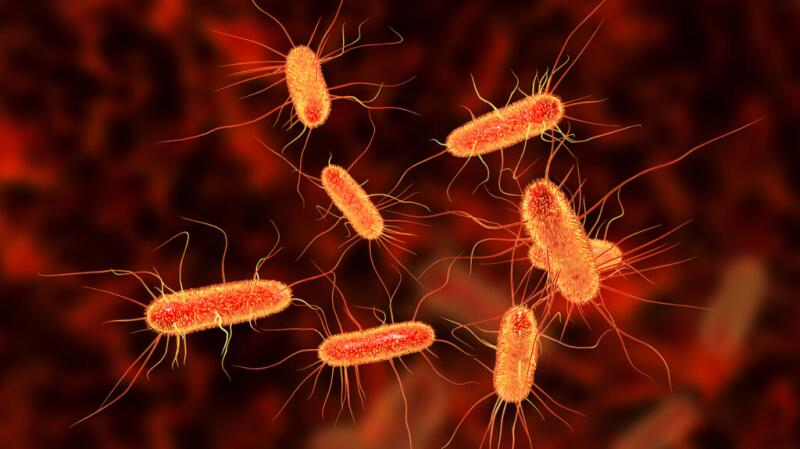E. coli-related diarrhea has no specific treatment. Instead, doctors manage it with supportive treatment, which involves administering extra fluids to avoid dehydration.
This article provides an overview of E. coli diarrheal infection, including its symptoms, causes, diagnosis, and treatment.
What is E. coli?

There are
When you hear that people are getting sick from E. coli, there are only
- Shiga toxin-producing E. coli (STEC), which is responsible for most outbreaks in the United States
- Other names for it include Verocytotoxin-producing E. coli and enterohemorrhagic E. coli. You may also hear people call it by the name of the most common strain of this subtype, E. coli O157:H7.
- enterotoxigenic E. coli, which is the most common cause of traveler’s diarrhea
- enteropathogenic E. coli, which was once a cause of outbreaks among infants and children but is now rare
- enteroinvasive E. coli, which is relatively rare
- enteroaggregative E. coli, which can also cause traveler’s diarrhea
- diffusely adherent E. coli
What are the signs and symptoms of an E. coli infection?
An E. coli diarrheal infection can show up anywhere from 1–10 days after exposure. Most people start having symptoms within 3–4 days of ingesting contaminated food or water.
Symptoms may include:
- mild fever or no fever at all
- nausea and vomiting
- stomach cramps, which are often the first symptom and can be severe
- watery diarrhea that may become bloody after 24 hours
Most people get better within 5–7 days. However, if you have diarrhea that lasts for longer than 3 days or diarrhea with a high fever, blood, or vomiting that prevents you from keeping down liquids, seek prompt medical care.
Prompt medical care is also necessary for the following symptoms of dehydration:
- dizziness or confusion
- fatigue
- increased thirst
- skin that remains tented after you pinch it
- very little urine or very dark urine
People can still spread bacteria for several weeks or possibly months after they feel better. Young children tend to carry them longer than adults.
How do you know you have an E. coli infection?
Visiting your doctor is the only way to know for sure if you have an E. coli infection. In
Taking a stool sample is not usually necessary. Diarrhea typically resolves on its own, whether it is due to a virus or E. coli. However, there are times when a stool sample is necessary, including in people with:
- an age of 70 years or above
- bloody diarrhea
- diarrhea lasting for longer than 7 days
- fever
- inflammatory bowel disease or a weakened immune system
- moderate to severe diarrhea
How do you treat an E. coli infection?
E. coli infections usually go away by themselves. These diarrheal infections are unpleasant but rarely dangerous. Treatment relies on preventing dehydration. It is important to drink lots of liquids. Oral rehydration solutions, broths, and bouillon are good choices to replace fluids and electrolytes.
You
What causes a person to get E. coli?
An E. coli infection starts when you swallow something that contains a disease-causing strain. This contamination has minuscule amounts of feces in it. These microscopic quantities can go undetected during food processing and preparation.
Undercooked ground meats, unpasteurized milk, and contaminated vegetables are some common sources of infection. With meat, the bacteria taint the meat during slaughter.
E. coli can also be present on people’s hands and in the following:
- animals — including cows, goats, and sheep — and their living areas
- feces of people with the infection
- raw fruits and vegetables, especially leafy greens and sprouts
- soft cheeses from raw milk
- soil
- unpasteurized milk and juice
- bodies of water, including lakes, ponds, streams, and swimming pools
Who is most at risk of an E. coli infection?
In the U.S., the average person’s risk of getting an E. coli infection is very low. About
Those at highest risk of an E. coli infection include:
- adults older than 65 years of age
- children younger than 5 years of age
- people with weakened immune systems, such as those taking immunosuppressant drugs and those with cancer, HIV, or diabetes
What are the complications of an E. coli infection?
Serious complications from E. coli are very rare. About
Symptoms of HUS tend to develop when diarrhea is improving, about 7 days after the illness begins. Symptoms include:
- feeling very tired
- losing the pink color in your cheeks and inside the lower eyelids
- urinating less frequently
People with HUS need hospitalization. Although most recover within a few weeks, permanent kidney damage and death are possible.
Doctors often recommend that people with high risk STEC are hospitalized for fluids and monitoring, especially if they are an older adult, a younger person, or someone who is immunocompromised.
In the U.S., about 30 people die each year from E. coli infections.
How can you protect yourself from an E. coli infection?

You can reduce your chance of getting sick from E. coli. Although your risk of an infection is already extremely low, you can take steps to
- Avoid eating high risk foods. Contaminated food causes more than half the cases of E. coli illness.
- Avoid untreated water.
- Stay away from people who are ill with an E. coli infection.
- Wash your hands before preparing food, after diapering infants, and after touching grazing animals — such as cows, sheep, or goats — or their surroundings.
- Use a food thermometer when you cook ground beef to make sure that it reaches an internal temperature of 160°F (71ºC).
High risk foods to avoid include:
- undercooked ground beef
- unpasteurized milk or juice
- soft cheeses made from unpasteurized milk
- unpasteurized apple cider
- alfalfa and raw bean sprouts
Frequently asked questions
Here are some more questions that people commonly ask about E. coli.
When should you see a doctor concerning E. coli?
Although most cases of E. coli are not dangerous, contact your doctor if your symptoms do not go away within a few days. Also, contact your doctor if you have bloody diarrhea, abdominal pain, high fever, or vomiting that prevents you from keeping down liquids.
How long does it take for E. coli to go away?
E. coli infections usually last about a week or less.
Is E. coli contagious?
People with an E. coli infection are very contagious. The infection can easily spread from person to person. Practice good hand hygiene and stay home to prevent transmission.
Summary
Although rare in the U.S., E. coli infections can cause significant diarrheal disease. They are a common cause of traveler’s diarrhea outside this country.
When outbreaks occur in the U.S., they are almost always due to the STEC subtype. Although most people recover within a few days, this subtype carries the risk of HUS. Contact your doctor if you develop bloody diarrhea or have diarrhea that lasts for longer than a few days.




